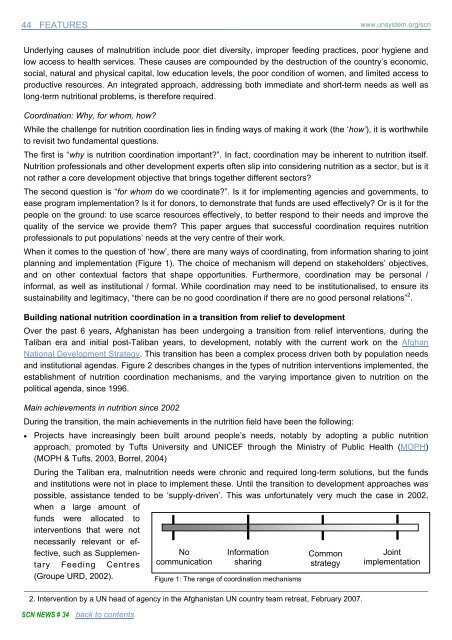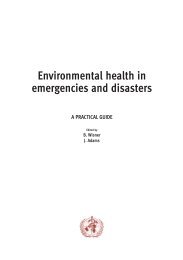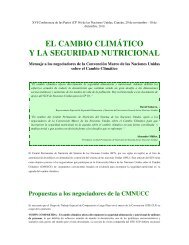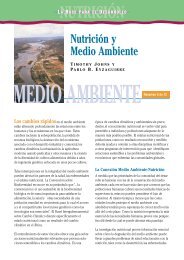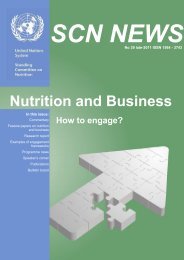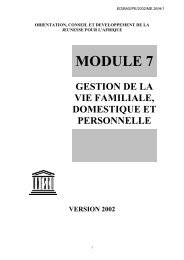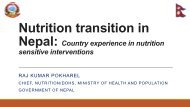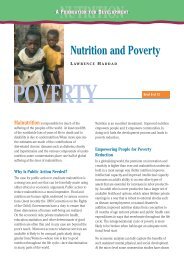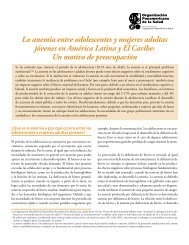SCN News No 34 - UNSCN
SCN News No 34 - UNSCN
SCN News No 34 - UNSCN
You also want an ePaper? Increase the reach of your titles
YUMPU automatically turns print PDFs into web optimized ePapers that Google loves.
44 FEATURES<br />
www.unsystem.org/scn<br />
Underlying causes of malnutrition include poor diet diversity, improper feeding practices, poor hygiene and<br />
low access to health services. These causes are compounded by the destruction of the country’s economic,<br />
social, natural and physical capital, low education levels, the poor condition of women, and limited access to<br />
productive resources. An integrated approach, addressing both immediate and short-term needs as well as<br />
long-term nutritional problems, is therefore required.<br />
Coordination: Why, for whom, how?<br />
While the challenge for nutrition coordination lies in finding ways of making it work (the ‘how’), it is worthwhile<br />
to revisit two fundamental questions.<br />
The first is “why is nutrition coordination important?”. In fact, coordination may be inherent to nutrition itself.<br />
Nutrition professionals and other development experts often slip into considering nutrition as a sector, but is it<br />
not rather a core development objective that brings together different sectors?<br />
The second question is “for whom do we coordinate?”. Is it for implementing agencies and governments, to<br />
ease program implementation? Is it for donors, to demonstrate that funds are used effectively? Or is it for the<br />
people on the ground: to use scarce resources effectively, to better respond to their needs and improve the<br />
quality of the service we provide them? This paper argues that successful coordination requires nutrition<br />
professionals to put populations’ needs at the very centre of their work.<br />
When it comes to the question of ‘how’, there are many ways of coordinating, from information sharing to joint<br />
planning and implementation (Figure 1). The choice of mechanism will depend on stakeholders’ objectives,<br />
and on other contextual factors that shape opportunities. Furthermore, coordination may be personal /<br />
informal, as well as institutional / formal. While coordination may need to be institutionalised, to ensure its<br />
sustainability and legitimacy, “there can be no good coordination if there are no good personal relations” 2 .<br />
Building national nutrition coordination in a transition from relief to development<br />
Over the past 6 years, Afghanistan has been undergoing a transition from relief interventions, during the<br />
Taliban era and initial post-Taliban years, to development, notably with the current work on the Afghan<br />
National Development Strategy. This transition has been a complex process driven both by population needs<br />
and institutional agendas. Figure 2 describes changes in the types of nutrition interventions implemented, the<br />
establishment of nutrition coordination mechanisms, and the varying importance given to nutrition on the<br />
political agenda, since 1996.<br />
Main achievements in nutrition since 2002<br />
During the transition, the main achievements in the nutrition field have been the following:<br />
• Projects have increasingly been built around people’s needs, notably by adopting a public nutrition<br />
approach, promoted by Tufts University and UNICEF through the Ministry of Public Health (MOPH)<br />
(MOPH & Tufts, 2003, Borrel, 2004)<br />
During the Taliban era, malnutrition needs were chronic and required long-term solutions, but the funds<br />
and institutions were not in place to implement these. Until the transition to development approaches was<br />
possible, assistance tended to be ‘supply-driven’. This was unfortunately very much the case in 2002,<br />
when a large amount of<br />
funds were allocated to<br />
interventions that were not<br />
necessarily relevant or effective,<br />
such as Supplementary<br />
Feeding Centres communication sharing<br />
strategy implementation<br />
<strong>No</strong> Information Common Joint<br />
(Groupe URD, 2002).<br />
Figure 1: The range of coordination mechanisms<br />
2. Intervention by a UN head of agency in the Afghanistan UN country team retreat, February 2007.<br />
<strong>SCN</strong> NEWS # <strong>34</strong> back to contents


